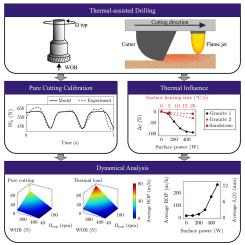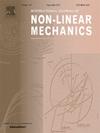Axial–torsional dynamic model of a drill-string considering thermal-assisted drilling
IF 3.2
3区 工程技术
Q2 MECHANICS
International Journal of Non-Linear Mechanics
Pub Date : 2025-10-10
DOI:10.1016/j.ijnonlinmec.2025.105279
引用次数: 0
Abstract
Thermal-assisted drilling, a recent advancement in drilling technology, aims to enhance process efficiency but its effects on drill-string dynamics remain largely unexplored. This paper presents an axial–torsional model with nonlinear bit-rock interaction coupling to investigate these effects. The first contribution is the proposition of a regularization method for a widely used nonlinear bit-rock interaction model. To validate the method, model parameters are calibrated against experimental data, demonstrating strong alignment with observed results. The second contribution is the integration of thermal effects into the bit-rock interaction, using thermal load inputs informed by previous experimental and numerical studies. Results show that under the most critical thermal load, the rate of penetration (ROP) increases by approximately 43%, highlighting the potential of thermal-assisted drilling to enhance drilling efficiency. Additionally, axial and torsional forces at the bit, along with the rotational speed of the bit, exhibit minimal variations under thermal conditions. These results indicate that thermal-assisted drilling can substantially improve ROP without compromising dynamic stability, offering new strategies for efficient and effective drilling operations.

考虑热辅助钻井的钻柱轴扭动力学模型
热辅助钻井是钻井技术的最新进展,旨在提高工艺效率,但其对钻柱动力学的影响在很大程度上仍未被探索。本文提出了一个具有非线性钻头-岩石相互作用耦合的轴扭模型来研究这些影响。第一个贡献是提出了一种广泛使用的非线性钻头-岩石相互作用模型的正则化方法。为了验证该方法,根据实验数据校准了模型参数,证明与观测结果有很强的一致性。第二个贡献是将热效应整合到钻头-岩石相互作用中,使用了以前的实验和数值研究提供的热负荷输入。结果表明,在最临界热负荷下,钻速(ROP)提高了约43%,凸显了热辅助钻井提高钻井效率的潜力。此外,在热条件下,钻头的轴向力和扭转力以及钻头的转速变化最小。这些结果表明,热辅助钻井可以在不影响动态稳定性的情况下大幅提高机械钻速,为高效钻井作业提供了新的策略。
本文章由计算机程序翻译,如有差异,请以英文原文为准。
求助全文
约1分钟内获得全文
求助全文
来源期刊
CiteScore
5.50
自引率
9.40%
发文量
192
审稿时长
67 days
期刊介绍:
The International Journal of Non-Linear Mechanics provides a specific medium for dissemination of high-quality research results in the various areas of theoretical, applied, and experimental mechanics of solids, fluids, structures, and systems where the phenomena are inherently non-linear.
The journal brings together original results in non-linear problems in elasticity, plasticity, dynamics, vibrations, wave-propagation, rheology, fluid-structure interaction systems, stability, biomechanics, micro- and nano-structures, materials, metamaterials, and in other diverse areas.
Papers may be analytical, computational or experimental in nature. Treatments of non-linear differential equations wherein solutions and properties of solutions are emphasized but physical aspects are not adequately relevant, will not be considered for possible publication. Both deterministic and stochastic approaches are fostered. Contributions pertaining to both established and emerging fields are encouraged.

 求助内容:
求助内容: 应助结果提醒方式:
应助结果提醒方式:


